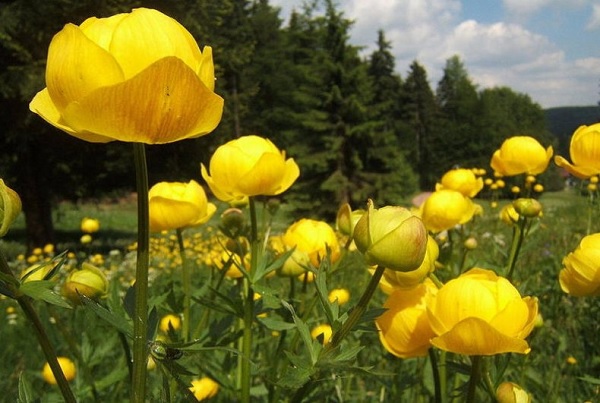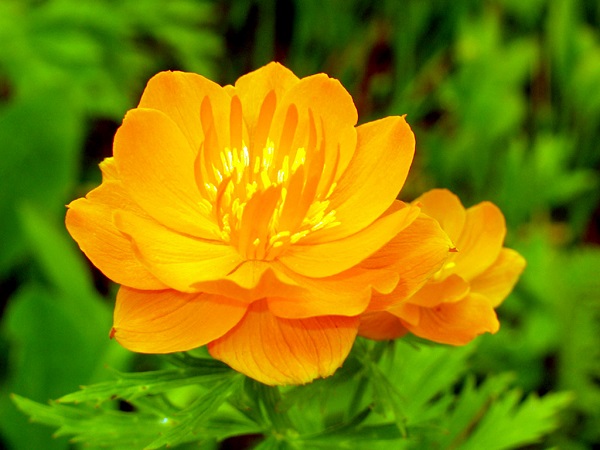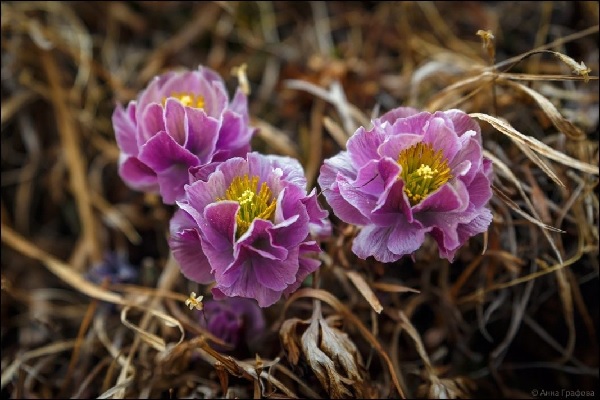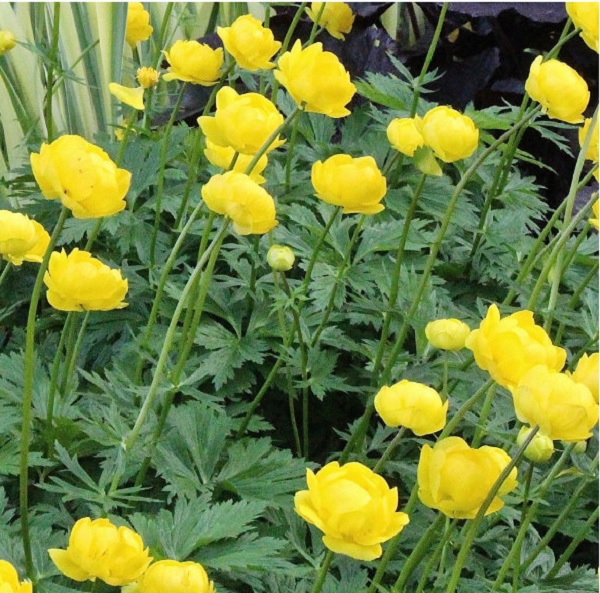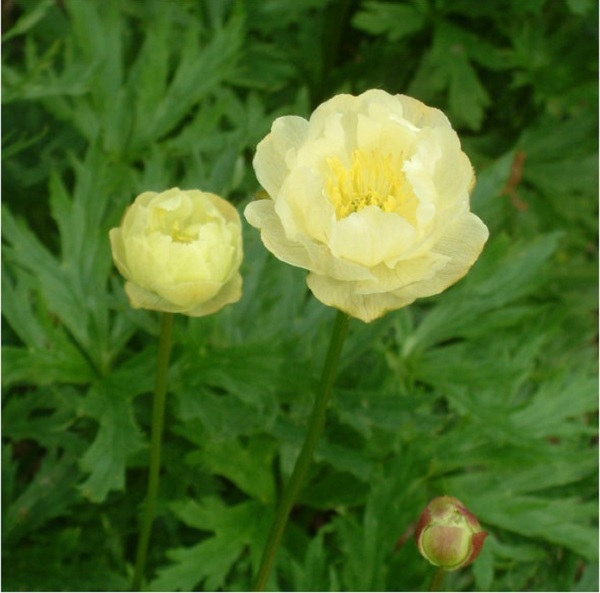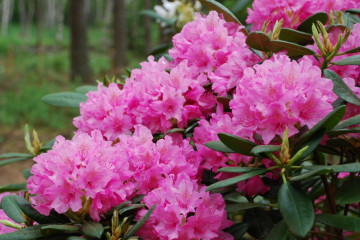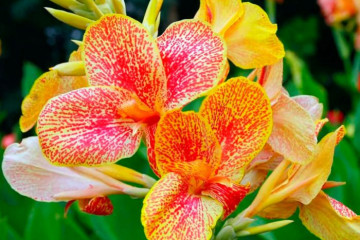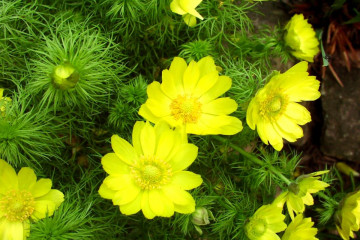Bather flower - description of the plant, planting and care in the garden
Content:
- What does a flower swimsuit look like?
- Types of swimwear and their characteristics
- Ledebour's Leotard (Trollius Ledebourii)
- Asian swimsuit (Trollius Asiaticus)
- European Leotard (Trollius Europaeus)
- The highest bather (Trollius Altissimus)
- Dwarf swimsuit (Trollius pumilus)
- Altai swimsuit (Trollius Altaicus)
- Cultural swimsuit (Trollius Cultorum)
- Paper-peel leotard (Trollius Chartosepalus)
- Half-open bather (Troilius Patulus)
- Lilac Leotard (Trollius Lilacinus)
- Large-petaled leotard (Trollius Macropetalus)
- The varieties most popular with gardeners
- Seed propagation
- Description of reproduction by division
- Features of care in the garden
- When and how it blooms
- Possible growing problems
- Use in landscape design
A bright yellow or even orange bathing suit is a very attractive flower in its own way, although it does not differ in its special richness of shapes and shades. In the garden, it is good because it blooms for a long time, and does not require special care.
What does a flower swimsuit look like?
This plant is also called a light in everyday life. This is not surprising, since it is distinguished by spherical flowers of fiery shades. The structure of the flower is very interesting: it consists of a perianth, resembling a corolla, and bright sepals, which can number from five to 20. The stamens in different species may differ in length. The nectars of this plant are modified petals. The honey pit is located at their base. The sweet scent of the lights attracts bees.
The fruits of this plant are leaflets that form a spherical compound fruit. The seeds are oval in shape and have a shiny black surface.
Briefly about the history of appearance
In the wild, lights have been distributed throughout Eurasia since ancient times. Their brief history should start with the fact that they have been grown in gardens for over 500 years and mainly for decorative purposes (while in the East, lights are considered medicinal plants). Planting and caring for the swimsuit did not require much effort, and this contributed to their popularity. But in those days, they bred mainly the European variety, all the rest appeared much later.
Why is the troll flower called
The Latin name for this flower is "Trollius". Many researchers believe that this name comes from "Trollblume", which translates as "flower of the trolls." Indeed, the bather plant grows well in humid places, where, according to legend, these fairy-tale characters also like to settle. In many legends, both Scandinavian and German, this plant is a favorite flower of the trolls, supposedly in its spherical flowers these creatures brew a healing drink.
However, there is another version of this name.Perhaps, given the spherical shape of the flower, the name comes from the Latin word "trulleus", meaning "round vessel."
Plant characteristics
In the wild, crop species can grow in a variety of conditions, which influenced their characteristics. For example, in Eastern Europe, bathers grow in forests, as well as in river valleys and near water bodies, so they prefer high humidity. In Western Europe and partly in Asia, lights grow in the mountains. These species are relatively drought tolerant. Regardless of whether they grow on the edge of the forest or in the mountains, all of these species are very resilient and unpretentious.
Types of swimwear and their characteristics
There are many varieties of this plant, which even differ in external characteristics.
Ledebour's Leotard (Trollius Ledebourii)
This is one of the most interesting views. The Ledebour Bathing Lady has a rather high peduncle (up to 1 m). Its large flowers reach 6 cm in diameter with bright orange petals. In culture, they can have large sizes up to 8 cm. The length of the nectaries is at least 1.5 cm. In gardening, different varieties of it are used, which may differ in the coloring of both petals and sepals.
Asian swimsuit (Trollius Asiaticus)
This type is widespread in landscape design. It is distinguished by bright orange flowers with separated sepals and clearly visible stamens.
In the wild, the height of the peduncle is about 40 cm, but at home it grows more noticeable - up to 70 cm.
European Leotard (Trollius Europaeus)
This species is also called an ordinary swimsuit. Its description says that its stems can reach 100 cm in height, which makes it one of the most notable varieties. The flowers are large in size and have a pleasant aroma. The color of the petals ranges from light yellow to golden. Their stamens are longer than petals. Blooms in late spring - early June.
The highest bather (Trollius Altissimus)
The main difference between this species is the height of the peduncle, it is 1.3-1.5 m. Moreover, the plant has quite beautiful openwork leaves. But the flowers of the tallest swimsuit are not too bright. They reach a diameter of 6 cm, but at the same time they are distinguished by a pale greenish-yellow tint.
Dwarf swimsuit (Trollius pumilus)
As the name suggests, this species is modest in size. The rosette of the plant is formed by carved leaves with a jagged edge. From there, in about mid-May, straight peduncles grow, which reach a height of 15-30 cm. But at the same time, their flowers are rather large, at least 2-3 cm in diameter. They are distinguished by a beautiful golden tinge of sepals.
Altai swimsuit (Trollius Altaicus)
This is a fairly tall variety. Its stem grows up to 90 cm in height. Differs in ajar flowers. Sepals have a red tint on the outside. Black pistils and anthers of dark red or purple color are visible inside the flower. Flowers appear at the end of May and delight the eye for a whole month.
Cultural swimsuit (Trollius Cultorum)
It differs from other species in that it is a hybrid. Its botanical "ancestors" are plants of four species at once. These are the Asian, European, Altai and large-petaled swimsuits described above. As a result, the garden leaves of the resulting swimsuit have a brighter juicy green hue. Peduncles grow up to 60-90 cm in height. The flowers are large, their average diameter is 7 cm.
A feature of this plant is also that its varieties differ in terms of flowering, you can even find those that will bloom until mid-July.
Paper-peel leotard (Trollius Chartosepalus)
This species is found in the wild in the northern regions. It is listed in the Red Book. This is a miniature plant, its height is only 15 cm. Its flowers are pale, most often of a cream shade. The diameter is about 3 cm.
Half-open bather (Troilius Patulus)
A feature of this species are low and practically non-branching stems. They rarely grow to a height of more than 35 cm. Her flowers are medium-sized, up to 30 cm in diameter, differing in a golden hue. After the end of flowering, the stem of the plant adds in length.
Lilac Leotard (Trollius Lilacinus)
If most varieties have yellow or orange flowers, less often cream, then this species has a very unusual purple color. But his nectaries are greenish-yellow, like other "relatives" growing in the Far East. In all other respects, it looks almost like an Asian variety. Is that the flowers are smaller, a maximum of 5 cm in diameter.
Large-petaled leotard (Trollius Macropetalus)
This variety has powerful peduncles that can reach a height of 100 cm. But the flower diameter is up to 5 cm. The colors are usual - yellow and orange. The leaves of this species are large, up to 15 cm wide.
The varieties most popular with gardeners
The most common varieties at the moment are:
- Goliath. This variety is distinguished by very large flowers, reaching a diameter of 7 cm. They attract attention not only by their size, but also by the beautiful light orange shade of nectaries;
- Orange King. Dark orange sepals are the main characteristic of this variety. Moreover, the plant is of medium size;
- Lemon queen. True to its name, this variety has lemon-yellow flowers;
- Lightball. The stems of this variety reach a height of 60 cm. The flowers have a beautiful light orange tint;
- Orange Princesses. This swimsuit is orange with wide-open flowers and tall stamens;
- Fire Globe. The variety is distinguished by orange nectaries and orange-red sepals, but otherwise looks very much like the Orange Princesses;
- Orange Glob. The flowers of this variety are large, bright orange, and the sepals are compact;
- Canary Bird - a variety of a yellow cultural swimsuit, that is, a hybrid variety with light flowers;
- Alabaster. Another hybrid variety, only a kind of cultured white swimsuit. Differs in relatively low bushes up to 60 cm in height;
- Elist of All. This is an early variety with bright yellow flowers reaching 7 cm in diameter. But the peduncles themselves are relatively low, up to 50 cm;
- Goal Cross. This variety looks very unusual: its sepals are yellow, and the nectaries are orange, so it looks beautiful, despite the fact that the flowers themselves are quite small;
- Goldkwell. A beautiful variety with spectacular and large bright yellow flowers, the diameter of which can reach 6 cm.
Seed propagation
For propagation of almost all types of swimsuit, it is better to use seeds, although grafting is theoretically possible, but it is considered a more complicated method.
The seed is harvested in July-August, depending on the flowering time of a particular variety.
Boarding time
Most often, seeds are sown in the ground after stratification, this happens already at the end of October or in November.
Mandatory seed stratification
Experienced gardeners mix seeds collected in August or July with slightly moistened sand, transfer this mixture to a bag and store it in the refrigerator in a box for vegetables at a temperature of 2-4 ° C. The seeds must stay there for three months to achieve the desired indicators.
Soil preparation
You need to grow a swimsuit in loose soil with good air permeability. Therefore, most often they make a mixture of two parts of peat, the same amount of earth and one part of sand.
Picking
Seedlings begin to appear in the first half of May. If hot weather sets in, they will develop actively, especially if you provide them with abundant watering and protection from the sun. They should be dived after a couple of full-fledged leaves appear on the seedlings. The sprouts are planted at a distance of 7-10 cm from each other. As a rule, a year later, already matured and overgrown plants are planted in a permanent place in the garden.
Can I transplant from a pot
As a rule, this perennial is immediately planted in open ground. But many gardeners plant it in a container for the first year. Then, in the second year, the question arises of how to plant a swimsuit from a pot. In this case, you must act carefully so as not to damage the roots.
Description of reproduction by division
The bather can reproduce by dividing the bushes. This method is suitable for experienced gardeners. This procedure is carried out only for healthy, well-developed five-year-old bushes. They are dug up, after which they try to gently rinse the roots, and then divide the rhizome with a sharp knife so that they get delenki with at least three buds for recovery. Plant them immediately to prevent drying out.
Features of care in the garden
Growing a flower of a swimsuit is not difficult even for a novice florist.
What conditions does a swimsuit like
Much depends on the climatic zone in which this perennial is grown. But in most of the territory of Russia, the lights prefer a weak shade. In open areas, unless the soil is too dry, this perennial does well.
What is the plant afraid of
During the growing period, the plant is afraid of a lack of moisture, so you need to provide the troll flower with regular watering. In addition, the light does not like transplanting, the bushes can grow in one place for at least 10 years. He also has a bad attitude to digging up the earth around the bush, since the root system is growing rapidly. These perennials produce a lot of adventitious stones, and digging can damage them.
Watering
To grow a healthy and beautifully flowering plant, the light should be watered regularly between March and July so that the soil is moist. In the period from August to September, the frequency and intensity of watering is reduced.
Mulching
This technique is optional when growing lights. But it saves the owner of the garden and garden from weeding at least this site, and even protects the soil from drying out, so you should not give it up.
Loosening
The weak point of this plant is that it does not like stagnant groundwater, which is why it requires regular loosening and good drainage of the soil.
Top dressing
All varieties of the European swimsuit develop well without requiring special care. Nevertheless, in order to improve the resistance of the troll flower to unfavorable environmental factors, experts advise treating with ash. This is done in early spring. Then, at the beginning of active growth, fertilizing with nitrogen fertilizers will be required. And only then, for better flowering, complex fertilizers are used.
Transfer
This perennial does not like transplants, and unless absolutely necessary, you should not bother him. But if the bushes grow too quickly, they are divided into several parts and transplanted.
When and how it blooms
Whether it is a white, yellow or orange swimsuit, this plant blooms very beautifully. Moreover, most varieties have a light sweetish aroma.
Types of flowers
In culture, there are varieties with regular or double flowers, consisting of five or 9-10 petals.
Flower shapes
The perennial swimsuit grass has only one flower shape - spherical. But the flowers can be half-open or open.
Flowering period
When a garden bather blooms, it depends on the particular variety. Most of them open flowers in the second half of May. In general, the flowering period lasts 3-4 weeks. Some varieties are pleasing to the eye until the end of July.
Changes in care during flowering
This plant is notable for its unpretentiousness, but when the swimsuit blooms, it does not require special care, with the exception of one nuance.
Possible growing problems
The bather is marsh grass. It does not grow in the most favorable conditions, therefore it is highly resilient and does not require special care.
Pests
This plant is toxic to insects, so it is not susceptible to pest attacks.
Diseases
The bather is highly immune to most diseases. However, the flower of the trolls can be threatened by fungus. To prevent infection, it is enough to cut off the dried leaves in time and observe the watering regime.
However, there is always a risk of picking up a fungus in the garden. Therefore, if this does happen, it is imperative to destroy the infected parts of the plant and treat it with a fungicide.
Signs of improper care
Premature yellowing of the leaves may indicate that the plant needs shading, since it receives an excess of sunlight.
Use in landscape design
This perennial plant is widely used in landscaping. Basically, it is planted when creating rock gardens, as well as rockeries, that is, rocky gardens.
This plant is beautifully combined in rockeries with edelweiss and yaskolka. But for this, miniature varieties are selected. For example, a dwarf swimsuit is suitable. Since after flowering the plant loses its decorative effect, and only by the fall a basal rosette grows at the swimsuit, it needs lush neighbors like Siberian irises and daylilies. From shrubs, it gets along well with Mahonia holly and Japanese spirea.
Thus, this is a universal flower that is unpretentious in care, is not afraid of parasites, and rarely clings to the infection. It is easy and simple to grow it. And its flowering is unforgettable.
